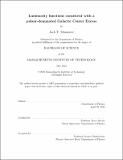Luminosity functions consistent with a pulsar-dominated Galactic Center Excess
Author(s)
Dinsmore, John T.
DownloadThesis PDF (1.162Mb)
Advisor
Slatyer, Tracy
Terms of use
Metadata
Show full item recordAbstract
A new population of millisecond pulsars is a long-standing proposed explanation for the excess of GeV-scale gamma rays emanating from the region surrounding the center of the Milky Way (the “Galactic Center excess”). We examine several simple parameterizations of possible luminosity functions for this population, as well as several benchmark luminosity functions proposed in the literature, and compare the predicted populations of resolved point sources to the Fermi 4FGL-DR2 point source catalog and a sub-population recently identified using wavelet-based methods. We provide general results that can be used to translate upper limits on the number of resolved point sources associated with the excess, and the fraction of the flux in the excess that can be attributed to resolved sources, into limits on the luminosity function parameter space. We discuss a number of important systematic uncertainties, including in the detection threshold model and the total flux attributed to the excess. We delineate regions of parameter space (containing existing benchmark models) where there is no apparent tension with current data, and the number of total pulsars needed to explain the excess is in the range of O(10⁴⁻⁵). In the future, lowered point source detection thresholds could be achieved either by new analysis methods or new data. An order-of-magnitude reduction in the sensitivity threshold (which may already be achieved by novel analyses probing sub-threshold source populations) could hope to resolve more than 30% of the flux of the excess even in pessimistic scenarios.
Date issued
2022-05Department
Massachusetts Institute of Technology. Department of PhysicsPublisher
Massachusetts Institute of Technology